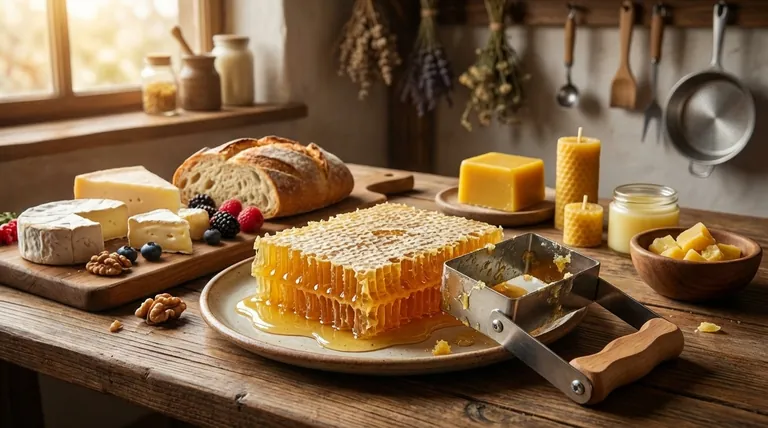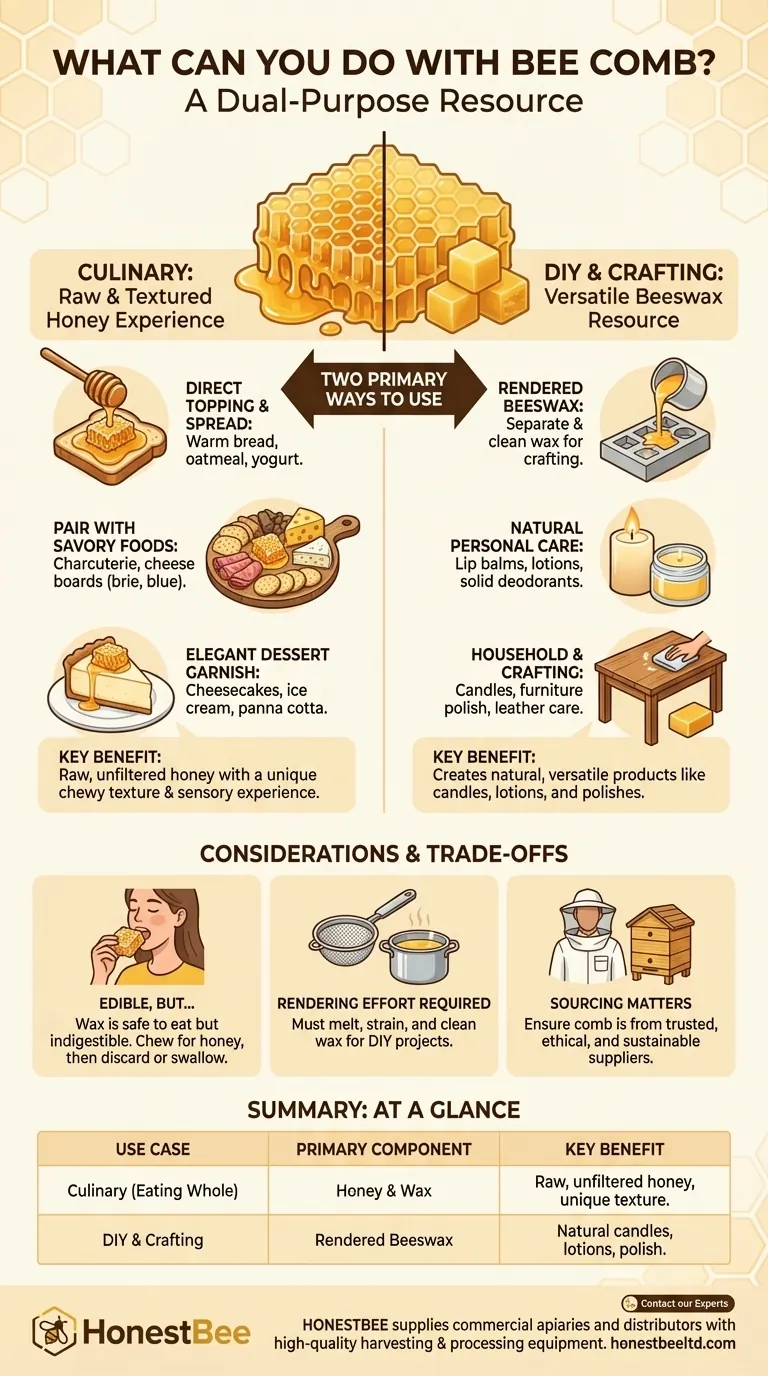In short, you can use bee comb in two primary ways: you can eat the entire structure—wax and all—as a natural and textured alternative to liquid honey, or you can render the beeswax from the comb to create a wide range of products, from candles and lotions to furniture polish.
Bee comb is not a single-use product; it's a dual-purpose resource. Its value lies in understanding that you have both raw, unfiltered honey for culinary use and pure, versatile beeswax for crafting and household applications.

What Exactly Is Bee Comb?
To use bee comb effectively, it's important to understand its composition. It's a remarkable natural structure with distinct, valuable parts.
A Structure of Pure Beeswax
The comb itself is a matrix of hexagonal cells built by honeybees from beeswax. This wax is a natural substance secreted by bees, making the physical structure itself a valuable material.
A Vessel for Raw Honey
Inside these wax cells, bees store their honey. Honey found in the comb is the rawest, most unfiltered version you can get, often containing trace amounts of pollen and propolis, which some believe add to its nutritional profile.
The Unique Sensory Experience
Eating honeycomb is a unique experience. It combines the familiar sweetness of honey with the soft, slightly chewy texture of the wax, which releases more honey as you chew.
Culinary Uses for Honeycomb
The most direct way to use bee comb is in the kitchen. Its unique form adds texture and visual appeal that liquid honey cannot match.
As a Direct Topping or Spread
Simply cut a piece of comb and spread it on warm bread, toast, or scones. The heat softens the wax slightly, making it easy to spread. It's also an excellent topping for oatmeal, yogurt, or pancakes.
Paired with Savory Foods
Honeycomb is a classic component of a charcuterie or cheese board. The intense, raw sweetness provides a perfect contrast to the salty, savory flavors of cured meats and rich cheeses, especially brie, goat cheese, or blue cheese.
An Elegant Garnish for Desserts
A small piece of honeycomb can elevate simple desserts. Place it atop a slice of cheesecake, a bowl of ice cream, or a creamy panna cotta for a touch of elegance and a burst of pure honey flavor. You can also chop it into smaller bits to top salads.
Beyond the Kitchen: The Value of Beeswax
Once the honey has been consumed or extracted, the remaining beeswax is a valuable resource for numerous Do-It-Yourself (DIY) projects.
Natural Personal Care Products
Beeswax is a common ingredient in cosmetics and balms because it acts as a natural emollient and thickener. You can render the wax from your comb to create your own lip balms, solid deodorants, and moisturizing lotions.
Household and Crafting Applications
The high melting point and protective qualities of beeswax make it ideal for household uses. It can be used to make natural, slow-burning candles. It is also the key ingredient in homemade polishes for furniture and leather, providing a protective, water-resistant sheen. It's even a component in some natural art supplies, like crayons.
Understanding the Trade-offs and Considerations
While bee comb is a fantastic natural product, there are a few practical points to keep in mind to get the most out of it.
The Wax Is Edible, But...
The beeswax is completely safe to eat, but your body does not digest it. Many people enjoy the chewy texture, while others prefer to chew it like a piece of gum, extracting all the honey, and then discard the remaining wax.
Rendering the Wax Requires Effort
To use beeswax for crafts like candles or lotions, you must first separate it from any remaining honey and clean it. This process involves melting the comb, straining out impurities, and allowing the pure wax to solidify.
Sourcing Matters
Always source your honeycomb from a trusted beekeeper or reputable supplier. This ensures the comb is clean, free of contaminants, and harvested ethically and sustainably.
Making the Right Choice for Your Comb
How you use your bee comb depends entirely on your goal.
- If your primary focus is a unique culinary experience: Use the comb whole on cheese boards, as a topping for breakfast dishes, or as an elegant dessert garnish.
- If your primary focus is crafting and DIY projects: Extract the honey for eating, then render the clean beeswax to create candles, balms, or polishes.
- If your primary focus is zero-waste and full utilization: Enjoy the honey and comb as a food item, and save any leftover bits of wax to render for small projects later.
By appreciating both the honey it holds and the wax it's made from, you can unlock the full potential of this incredible product of the hive.
Summary Table:
| Use Case | Primary Component | Key Benefit |
|---|---|---|
| Culinary (Eating Whole) | Honey & Wax | Raw, unfiltered honey with unique chewy texture. |
| DIY & Crafting | Rendered Beeswax | Creates natural candles, lotions, and furniture polish. |
Ready to explore the full potential of bee products? HONESTBEE supplies commercial apiaries and beekeeping equipment distributors with the high-quality supplies needed to harvest and process honeycomb efficiently. Whether you're scaling your honey production or developing new beeswax-based products, our wholesale-focused operations provide the reliable equipment you need. Contact our experts today to discuss how we can support your business.
Visual Guide

Related Products
- Heavy Duty Stainless Steel Honeycomb Cutter
- Electric Honey Press Machine for Squeezing Honey Comb Press Equipment
- Wooden Bee Brush with Triple Row Artificial Fiber for Beekeeping
- Professional Frame Preparation: The HONESTBEE Electric Wire Embedder
- Stainless Steel Manual Honey Press with Guard for Pressing Honey and Wax
People Also Ask
- What are the uses of honey in various industries? Unlock Its Functional Power in Food, Pharma & Cosmetics
- What qualities are important for someone starting in beekeeping? Build a Thriving Apiary with the Right Mindset
- When can new beekeepers expect to harvest honey? A Guide to Your First Successful Harvest
- What equipment do you need to make honey? A Complete Guide to Starting Your Apiary
- What are the features of a stainless steel honey uncapping knife? Unlock a Cleaner, More Efficient Harvest



















